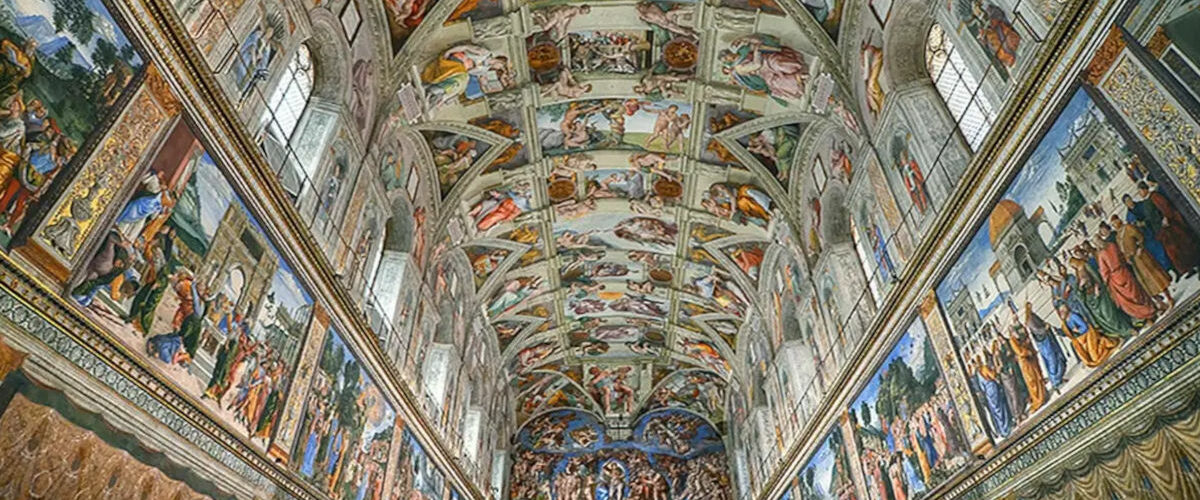Michelangelo Buonarroti, renowned as one of the greatest artists of the Italian Renaissance, left an indelible mark on the world of art with his extraordinary talents in painting, sculpture, and architecture. While he is often celebrated for his sculptures like the David and the Pietà, his paintings also hold immense significance in the art world. Michelangelo’s paintings are not only rare but also highly sought after, fetching exorbitant prices when they occasionally come up for sale.
A Visionary of Renaissance Artistry and Enduring Legacy
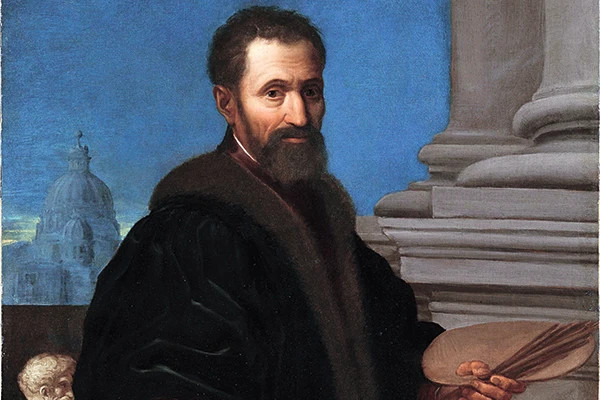
Michelangelo’s work stands out from others primarily due to his unparalleled skill, revolutionary creativity, and profound emotional depth. Born in 1475 in Caprese, Italy, Michelangelo Buonarroti emerged during the High Renaissance period, a time of flourishing artistic achievement in Italy. His works span various mediums, including sculpture, painting, and architecture, with masterpieces like the David sculpture, the Sistine Chapel Ceiling, and the dome of St. Peter’s Basilica. Michelangelo’s artistic prowess transcended conventional boundaries, pushing the limits of human expression and representation. His ability to infuse his creations with intense emotion, dynamic movement, and spiritual resonance set him apart as a true visionary of his time.
Michelangelo’s works belong to the High Renaissance style, characterized by a harmonious balance of form, proportion, and naturalism. His meticulous attention to anatomical detail, coupled with his profound understanding of human psychology, imbued his art with a timeless quality that continues to captivate audiences centuries later. Michelangelo’s popularity stems from his ability to capture the essence of the human experience, transcending cultural and temporal boundaries to resonate with people from all walks of life. His enduring legacy as one of the greatest artists in history is a testament to the universal appeal of his timeless creations.
Michelangelo’s work also stands out for its monumental scale and ambitious scope. Whether it’s the breathtaking expanse of the Sistine Chapel Ceiling or the towering presence of the David sculpture, Michelangelo consistently pushed the boundaries of artistic achievement. Creating works of unparalleled grandeur and significance. Moreover, his relentless pursuit of perfection and unwavering dedication to his craft set a standard for artistic excellence that continues to inspire generations of artists. Michelangelo’s ability to seamlessly blend classical ideals with his own innovative vision revolutionized the art world. Earning him a lasting legacy as a titan of Renaissance art.
The works of Michelangelo
Among Michelangelo’s paintings, several stand out both in terms of their artistic brilliance and their astronomical market value. Let’s delve into the stories behind the five most expensive and popular paintings attributed to Michelangelo:
1. The Sistine Chapel Ceiling (1508-1512):
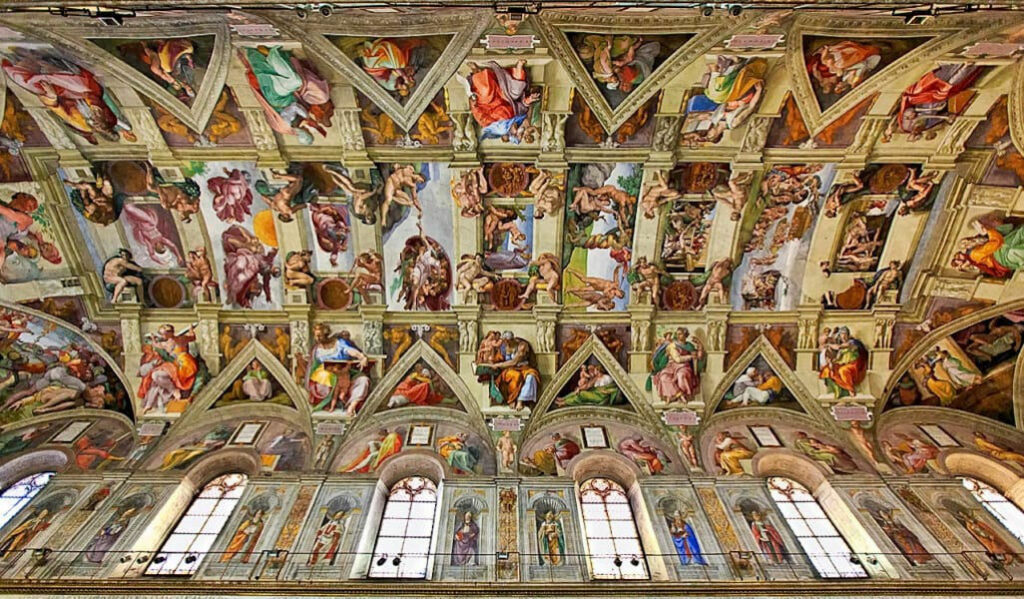
One intriguing aspect of the creation of the Sistine Chapel Ceiling is the immense physical and mental toll it took on Michelangelo. The project was an arduous undertaking that required the artist to work for nearly four years in uncomfortable and physically demanding conditions. Michelangelo spent countless hours lying on his back atop scaffolding, painting the intricate frescoes on the chapel ceiling, often enduring neck strain, eye strain, and muscle fatigue.
Despite the challenges, Michelangelo persevered, driven by his unwavering dedication to his craft and his desire to create a masterpiece worthy of the divine space of the Sistine Chapel. His commitment to excellence and his extraordinary artistic vision ultimately resulted in one of the most iconic and enduring works of art in history.
Another interesting aspect of the Sistine Chapel Ceiling is the hidden messages and symbolism embedded within its composition. Michelangelo incorporated numerous allegorical figures, biblical narratives, and symbolic motifs throughout the frescoes, each layering meaning and complexity onto the overall design. For example, the depiction of the Creation of Adam, with God’s outstretched hand reaching towards Adam’s, has become one of the most iconic images in Western art, symbolizing the moment of divine creation and the imparting of life to humanity.
The Sistine Chapel Ceiling stands not only as a testament to Michelangelo’s unparalleled skill and creativity but also as a rich tapestry of symbolism and meaning that continues to captivate and inspire viewers centuries after its completion.
Where is the masterpiece and who owns it
The Sistine Chapel Ceiling is located within the Vatican City, specifically in the Vatican Museums. Sistine Chapel itself is part of the Apostolic Palace, the official residence of the Pope in Vatican City. The chapel is renowned for its stunning frescoes, including Michelangelo’s masterpiece on the ceiling, which depicts various scenes from the Book of Genesis. The Vatican Museums are a major tourist destination. Attracting millions of visitors each year who come to admire the unparalleled beauty and historical significance of the Sistine Chapel Ceiling and other priceless works of art housed within its walls.
- Arguably Michelangelo’s most famous work, the Sistine Chapel Ceiling is a monumental fresco depicting scenes from the Book of Genesis. Its rarity lies not only in its artistic grandeur but also in its sheer size and complexity.
- This masterpiece is not privately owned but is part of the Vatican Museums’ collection, making it inaccessible to private collectors. The last time it “sold” was in the 16th century when Pope Julius II commissioned Michelangelo for the project.
- While there’s no definitive monetary value due to its irreplaceable status, estimates suggest its worth would be in the billions if it were ever to be put on the market.
2. The Last Judgment (1536-1541):
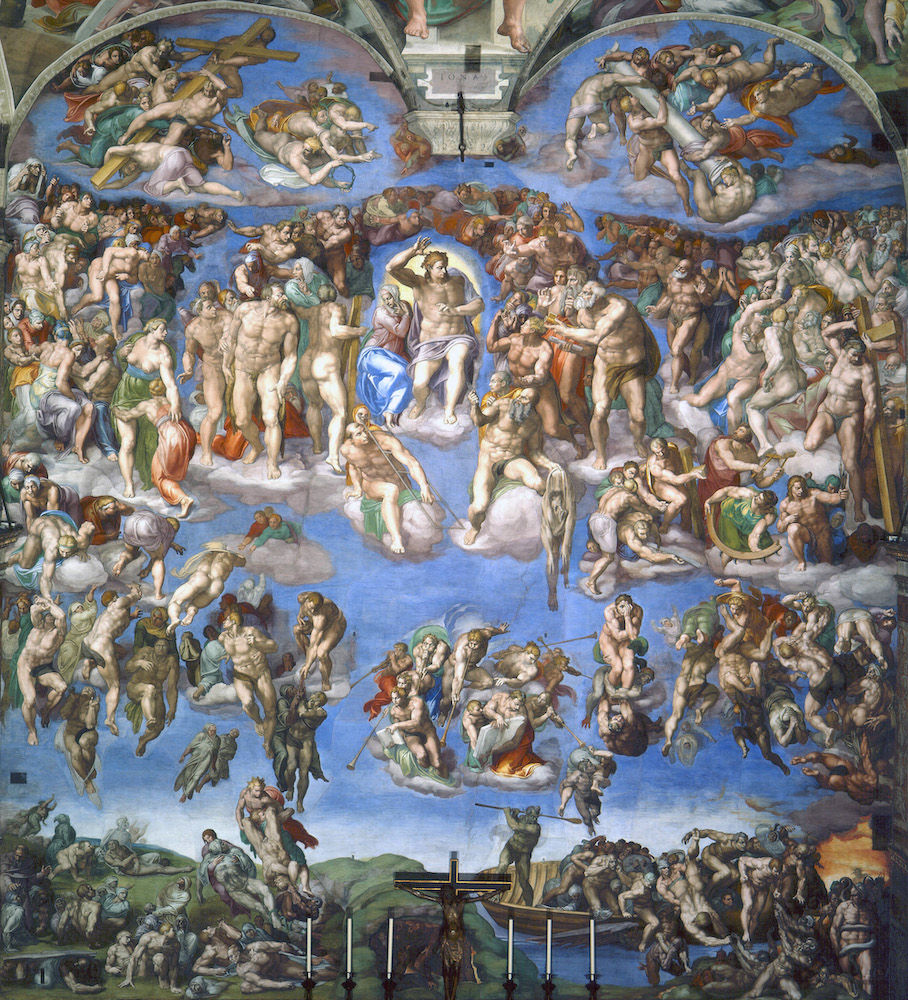
One fascinating aspect of “The Last Judgment” is the controversy it sparked during its creation and after its unveiling. Michelangelo’s depiction of the human form in various states of undress and torment, particularly the portrayal of nude figures, stirred considerable debate among contemporary clergy members and theologians. Some deemed the nudity inappropriate for a sacred space like the Sistine Chapel, while others praised Michelangelo’s bold artistic choices as a testament to the human condition and the power of divine judgment.
Additionally, Michelangelo included several allegorical elements and hidden references within the composition of “The Last Judgment.” For example, some art historians suggest that Michelangelo inserted his own self-portrait into the fresco, depicting himself as the flayed skin held by St. Bartholomew, symbolizing the artist’s introspective reflection on his own mortality and spiritual journey.
Despite the controversy surrounding its creation, “The Last Judgment” remains a masterpiece of Renaissance art, admired for its emotional intensity, dynamic composition, and profound theological significance.
Where is the masterpiece and who owns it
“The Last Judgment” is another monumental fresco by Michelangelo, located in the Sistine Chapel within the Vatican City. Positioned on the altar wall of the chapel, it depicts the Second Coming of Christ and the final judgment of souls. The Sistine Chapel, renowned for its extraordinary frescoes, is part of the Vatican Museums complex. Making it accessible to visitors from around the world. “The Last Judgment” is a central masterpiece within the chapel. Contributing to its significance as one of the most important artistic and religious sites in the world.
- Painted on the altar wall of the Sistine Chapel, The Last Judgment is another monumental fresco by Michelangelo. Portraying the Second Coming of Christ and the final judgment of souls.
- Like the Sistine Chapel Ceiling, The Last Judgment remains in the Vatican Museums’ collection and is not available for purchase. It has never been sold since its creation.
- Although its market value is incalculable, its cultural and historical significance renders it priceless.
3. The Doni Tondo (c. 1507):
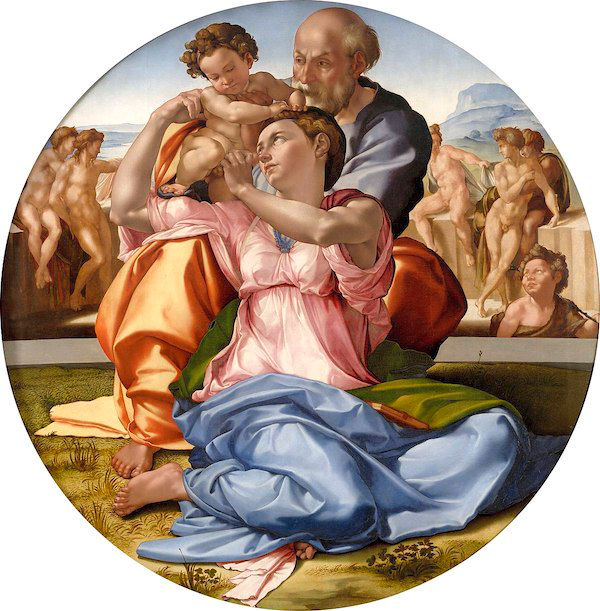
Fascinating aspect of The Doni Tondo is its innovative composition and unique portrayal of the Holy Family. Unlike traditional depictions of the Holy Family, which often feature static figures in rigid poses, Michelangelo’s Doni Tondo presents a dynamic and emotionally charged scene. The figures of Mary, Joseph, the infant Jesus, and St. John the Baptist are intertwined in a circular composition, creating a sense of movement and intimacy. This innovative approach reflects Michelangelo’s mastery of form and his ability to infuse his subjects with vitality and emotion.
Moreover, The Doni Tondo is renowned for its intricate symbolism and theological depth. The circular format of the painting, known as a “tondo,” symbolizes the eternal and unbroken bond of the Holy Family. Additionally, the inclusion of St. John the Baptist holding a small cross and pointing towards Jesus alludes to Christ’s future sacrifice and redemption. These symbolic elements add layers of meaning to the painting, inviting viewers to contemplate the deeper spiritual significance of the scene.
Furthermore, The Doni Tondo showcases Michelangelo’s skillful use of color and light to enhance the dramatic impact of the composition. The vivid hues and subtle chiaroscuro effects create a sense of depth and atmosphere, drawing viewers into the sacred moment depicted on the canvas.
Overall, The Doni Tondo stands as a masterpiece of Renaissance art, celebrated for its innovative composition, profound symbolism, and emotional resonance. It exemplifies Michelangelo’s ability to transcend convention and breathe new life into traditional religious subjects, leaving a lasting legacy in the annals of art history.
Where is the masterpiece and who owns it
The Doni Tondo, also known as the Holy Family, is currently housed in the Uffizi Gallery in Florence, Italy. The Uffizi Gallery is renowned for its vast collection of Italian Renaissance artworks, making it one of the most prominent art museums in the world. The Doni Tondo belongs to the collection of the Uffizi Gallery and is publicly accessible for viewing by visitors from around the globe.
- The Doni Tondo, also known as the Holy Family, is a circular painting depicting the Holy Family with St. John the Baptist. It is renowned for its innovative composition and emotional intensity.
- Unlike the Sistine Chapel masterpieces, the Doni Tondo is privately owned. The last known sale of the painting was in 2008 when it was acquired by the Uffizi Gallery in Florence for an undisclosed amount. Estimated to be in the tens of millions of dollars.
- The painting’s narrative centers on the Holy Family and is imbued with symbolic significance. Reflecting Michelangelo’s profound religious beliefs and artistic vision.
4. The Manchester Madonna (c. 1497-1499):
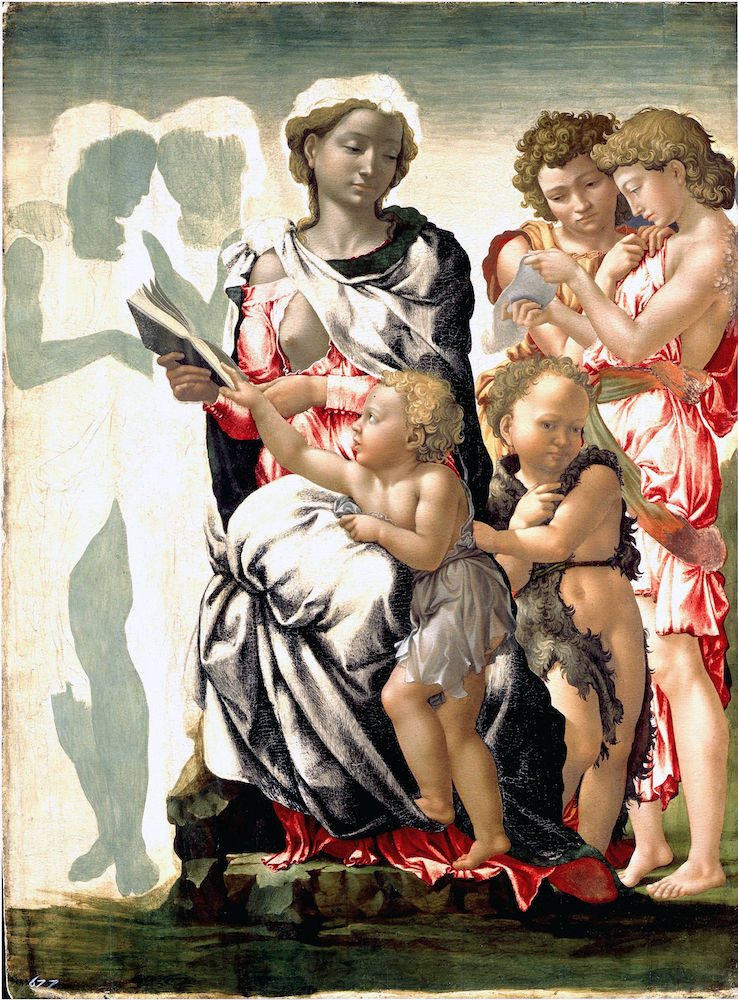
One intriguing aspect of The Manchester Madonna is its portrayal of the Madonna and Child within a domestic setting, a departure from traditional depictions of the Holy Family in majestic or celestial settings. In this painting, Michelangelo presents Mary and the infant Jesus in a humble, intimate setting, seated on a simple stone bench with a landscape visible through an open window behind them. This domestic scene humanizes the figures of Mary and Jesus, emphasizing their humanity and relatability to viewers.
Moreover, The Manchester Madonna is renowned for its exquisite attention to detail and meticulous rendering of form. Michelangelo’s mastery of anatomy is evident in the naturalistic poses and lifelike expressions of the figures. Reflecting his profound understanding of human anatomy and emotion. The delicate interplay of light and shadow further enhances the sense of realism. Imbuing the painting with a sense of depth and dimensionality.
Additionally, The Manchester Madonna is celebrated for its timeless beauty and emotional resonance. The tender interaction between Mary and the infant Jesus conveys a sense of maternal love and devotion, inviting viewers to contemplate the sacred bond between mother and child. This universal theme of love and compassion transcends cultural and temporal boundaries, resonating with viewers across generations.
Overall, The Manchester Madonna stands as a testament to Michelangelo’s extraordinary talent and artistic vision. By portraying the Madonna and Child in a domestic setting with sensitivity and grace, Michelangelo imbued the painting with a sense of humanity and intimacy that continues to captivate and inspire viewers centuries later.
Where is the masterpiece and who owns it
The Manchester Madonna, also known as the Holy Family with St. John the Baptist, is currently housed in the National Gallery in London, United Kingdom. As a part of the National Gallery’s collection. It belongs to the public domain and is accessible for viewing by visitors to the museum.
- The Manchester Madonna, also known as the Holy Family with St. John the Baptist, is a panel painting showcasing Michelangelo’s early mastery of form and expression.
- Currently housed in the National Gallery in London, the Manchester Madonna is not privately owned. Its last sale dates back centuries, and its current value is immeasurable.
- The painting depicts the tender interaction between the Madonna, the Christ Child, St. John the Baptist. And the infant St. John’s lamb, evoking themes of maternal love and divine grace.
5. The Entombment (c. 1500-1501):
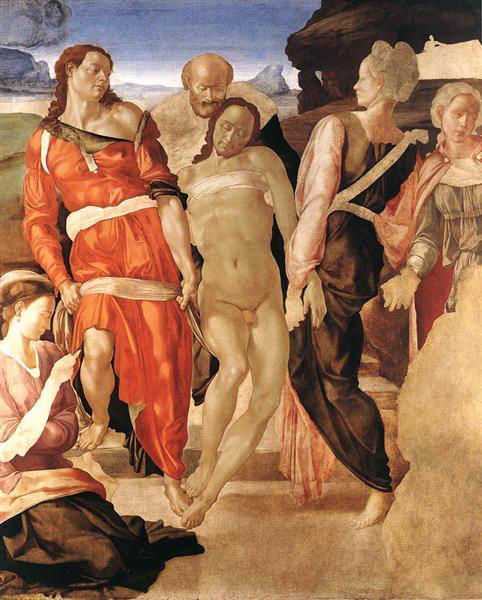
One fascinating aspect of The Entombment is its emotional intensity and dramatic portrayal of grief and despair. The painting depicts the moment following the Crucifixion when the lifeless body of Jesus is being mourned and prepared for burial. Michelangelo masterfully captures the raw emotion of the scene, portraying the anguish and sorrow of the figures surrounding Christ’s body.
Moreover, The Entombment is renowned for its innovative composition and dynamic movement. Michelangelo deftly arranges the figures in a pyramidal composition. Drawing the viewer’s eye towards the central figure of Christ while creating a sense of depth and perspective. The figures’ twisting and contorted poses convey a sense of physical and emotional tension, heightening the drama of the scene.
Additionally, The Entombment showcases Michelangelo’s skillful use of light and shadow to enhance the dramatic impact of the composition. The stark contrast between light and dark accentuates the figures’ expressive faces and gestures, heightening the sense of drama and emotion.
Furthermore, The Entombment is celebrated for its rich symbolism and theological depth. The painting conveys themes of suffering, redemption, and the triumph of faith over death. Inviting viewers to contemplate the profound meaning of Christ’s sacrifice. This universal message of hope and salvation resonates with viewers across cultures and generations. Making The Entombment a timeless masterpiece of religious art.
Overall, The Entombment stands as a testament to Michelangelo’s unparalleled skill and artistic vision. Through its powerful portrayal of grief and redemption, the painting invites viewers to reflect on the enduring significance of Christ’s sacrifice and the promise of salvation for all humanity.
Where is the masterpiece and who owns it
The Entombment is currently housed in the National Gallery in London, United Kingdom. As with other works in the National Gallery’s collection. It belongs to the public domain and is accessible for viewing by visitors to the museum.
- The Entombment is a poignant depiction of the entombment of Christ after his crucifixion, conveying profound emotion and spiritual depth.
- This painting is currently part of the collection at the National Gallery in London and is not privately owned. Like other works in public collections, it has not been sold since its acquisition.
- Michelangelo’s composition captures the grief and despair of those mourning Christ’s death. Making it a powerful portrayal of human suffering and redemption.
In conclusion, Michelangelo’s paintings represent some of the most extraordinary achievements in Western art history. While their rarity and value vary, they all share a timeless beauty and significance that continue to captivate audiences worldwide. Whether housed in prestigious museums or held in private collections. These masterpieces serve as enduring testaments to Michelangelo’s unparalleled genius and artistic legacy.
